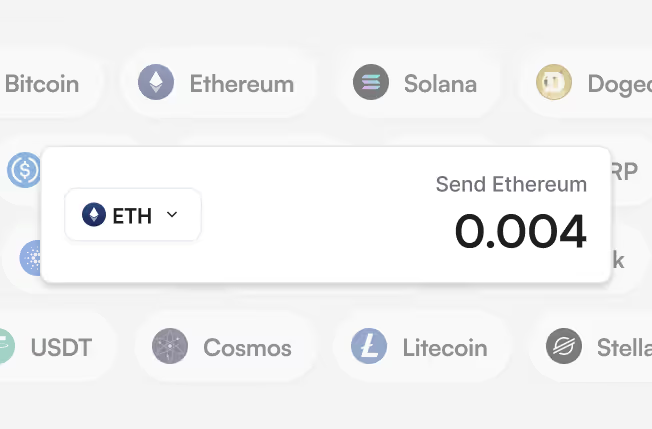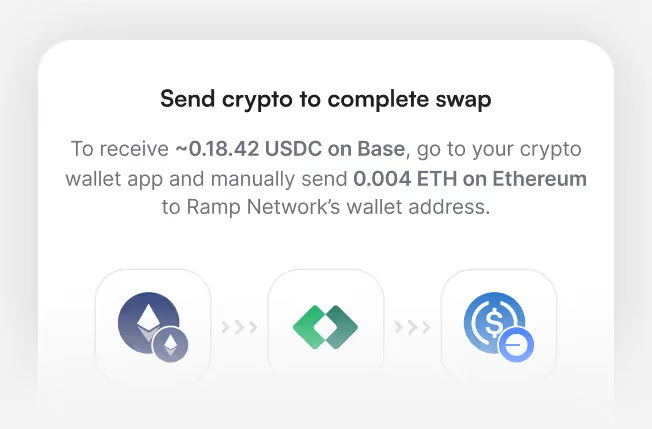


Swap Bitcoin for Solana instantly.
Exchange Bitcoin (BTC) for Solana (SOL) in a fast, secure flow – no complex bridges or decentralized exchanges needed.


.svg)










Exchange Bitcoin (BTC) for Solana (SOL) in a fast, secure flow – no complex bridges or decentralized exchanges needed.


.svg)







Swapping Bitcoin (BTC) for Solana (SOL) is simple and secure with Ramp Network. The process is designed to stay clear and user-friendly from start to finish.

1
Choose Bitcoin (BTC) and Solana (SOL), enter the amount you want to swap, and check the real-time exchange rate before continuing.

2
Sign up using your preferred method and confirm your country of residence to proceed.

3
Ramp Network supports both self-custodial wallets like Ledger or Trezor and custodial exchange accounts. You stay in control throughout the process.

4
Transfer the BTC from your wallet. Once the transaction is confirmed on the network, SOL is delivered directly to your chosen wallet or exchange account.

Ramp Network supports both self-custodial wallets like Ledger or Trezor and custodial exchange accounts. When swapping BTC for SOL, you simply connect your wallets, review the details, and confirm the exchange.






The flow is designed to stay clear and easy to follow. Ramp Network avoids complex blockchain terminology, making BTC-to-SOL swaps accessible even for first-time users.
You remain in full control of your assets. BTC is transferred directly from your wallet, and SOL is delivered to the wallet or exchange account you choose. Ramp Network does not hold your funds.
Ramp Network operates in key markets such as the UK, EU, and US. Availability and supported networks are displayed during the checkout process.

Before completing your BTC-for-SOL swap, all relevant details, including costs and exchange rates, are clearly shown, so you always know what to expect.
*When compared to transferring via an exchange

Bitcoin started as an idea – a simple post on a mailing list in 2009 that said money could exist without banks. At first, hardly anyone paid attention. But over time, people realized that this open network, running without a central authority, actually worked. Every transaction is verified publicly, visible to anyone who wants to check.
What makes Bitcoin different is that there will never be more than 21 million of them. No extra printing, no hidden inflation. Some people see that as digital gold; others just like the freedom of sending value anywhere, at any time, without asking for permission.
Over the years, Bitcoin grew from a small tech experiment to a global payment and savings tool. Freelancers get paid in BTC, families use it for remittances, and institutions now hold it as part of their reserves. It’s no longer a niche project, it’s part of the financial conversation everywhere.
Bitcoin (BTC) is the world’s first cryptocurrency, launched in 2009 by the mysterious creator known as Satoshi Nakamoto. Built on blockchain technology, Bitcoin introduced a new way of transferring value online without the need for banks or intermediaries. Its decentralized nature, combined with a fixed supply of 21 million coins, makes it a unique digital asset often referred to as “digital gold.”
Today, Bitcoin is the most recognized and widely used cryptocurrency worldwide. Millions of people use it for trading, investing, and cross-border payments, while businesses across industries accept Bitcoin payments as a secure and transparent alternative to traditional money. Its popularity continues to grow, supported by increasing adoption from financial institutions, mainstream investors, and even governments exploring Bitcoin regulation.
What makes Bitcoin special is its combination of scarcity, security, and decentralization. Unlike fiat currencies that can be printed endlessly, Bitcoin’s supply is limited, creating long-term value potential. Its blockchain is maintained by thousands of nodes across the globe, ensuring transactions remain transparent and resistant to censorship. For many users, Bitcoin represents more than just an investment — it’s a revolutionary step toward financial freedom and the future of money.
The chart displays an indicative, mid-market exchange rate. Effective exchange rate might be different.

If Bitcoin was about independence, Solana is about performance. Launched in 2020 by Anatoly Yakovenko, it was built for one thing: speed. Transactions on Solana confirm in seconds, and fees cost less than a cent. That’s why NFT markets, gaming projects, and DeFi apps started showing up there almost immediately.
The network runs on something called Proof-of-History, a built-in clock that helps keep everything in sync, even when thousands of people use it at the same time. For users, that means smooth, fast transfers. For developers, it’s a chance to build complex apps without worrying about slow block times.
SOL is what powers it all. It’s used for staking, for paying transaction fees, and for taking part in governance. Solana isn’t perfect, no network is, but it keeps improving fast. For many, it feels like the blockchain where speed finally caught up with ambition.
Bitcoin (BTC) is the world’s first cryptocurrency, launched in 2009 by the mysterious creator known as Satoshi Nakamoto. Built on blockchain technology, Bitcoin introduced a new way of transferring value online without the need for banks or intermediaries. Its decentralized nature, combined with a fixed supply of 21 million coins, makes it a unique digital asset often referred to as “digital gold.”
Today, Bitcoin is the most recognized and widely used cryptocurrency worldwide. Millions of people use it for trading, investing, and cross-border payments, while businesses across industries accept Bitcoin payments as a secure and transparent alternative to traditional money. Its popularity continues to grow, supported by increasing adoption from financial institutions, mainstream investors, and even governments exploring Bitcoin regulation.
What makes Bitcoin special is its combination of scarcity, security, and decentralization. Unlike fiat currencies that can be printed endlessly, Bitcoin’s supply is limited, creating long-term value potential. Its blockchain is maintained by thousands of nodes across the globe, ensuring transactions remain transparent and resistant to censorship. For many users, Bitcoin represents more than just an investment — it’s a revolutionary step toward financial freedom and the future of money.
The chart displays an indicative, mid-market exchange rate. Effective exchange rate might be different.
Customers like you have traded over $1 billion in crypto with Ramp Network.